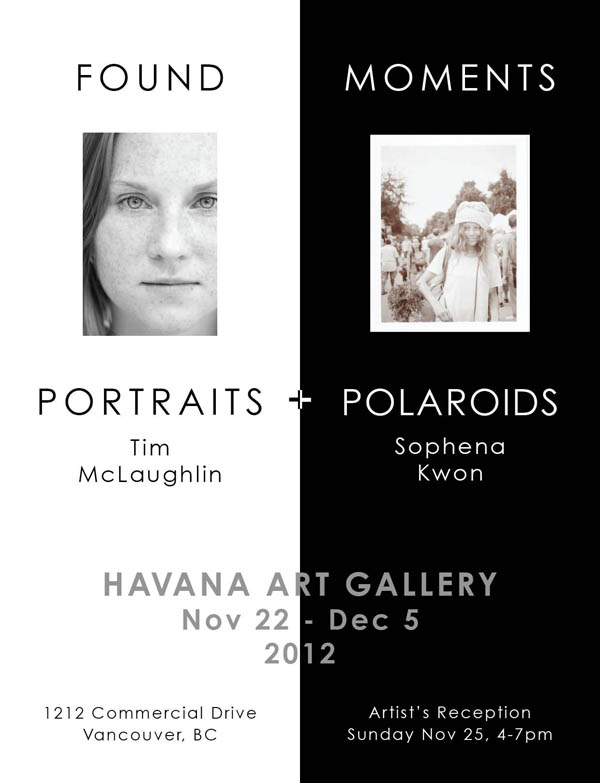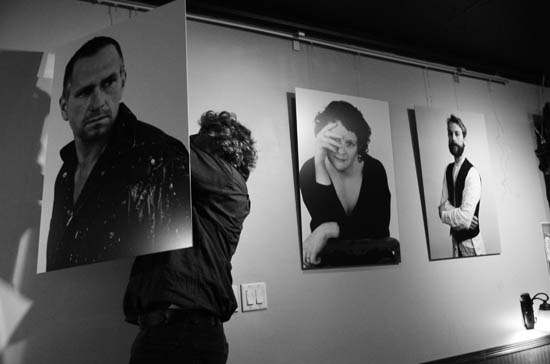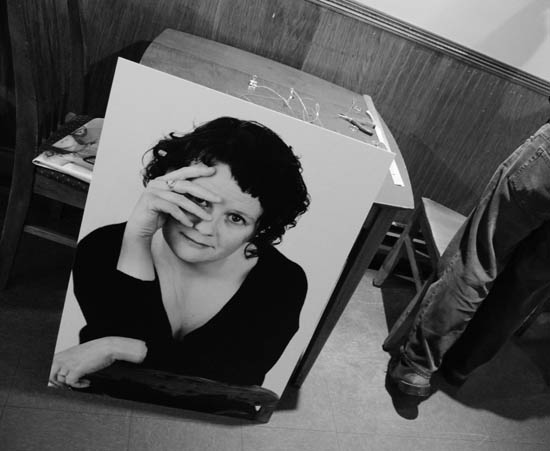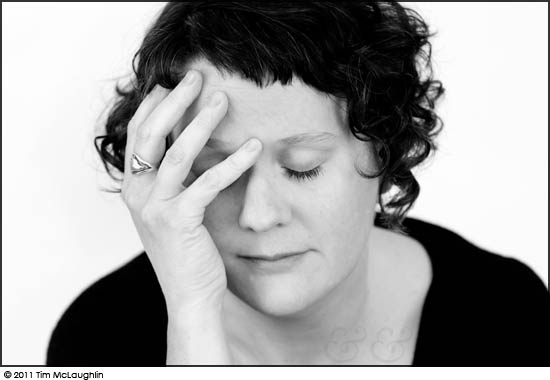Show at the Havana Art Gallery
There will be a reception on Sunday November 25th. Official times are 4 - 7pm, but we will likely be there late. Please drop by and enjoy a glass of wine with us.
Robert Studer
Robert Studer, sculptor and installation artist. Taken June 18th, 2012.
These portraits might be an attempt to make people into theatre. To this end they are not portraits of individuals at all, but rather depictions of characters. As if each person was an actor playing themselves in the movie version of his or her life. And so the meaning of the photo is not - Who is this individual, have I captured the essence of this person? But rather a larger question, who is this character? What is the nature of this story? ... and what is the meaning of theatre? or narrative? or even life itself.
Robert is the maker of a fantastic body of work. Some idea of his energy and the scale of his thinking can be found at THIS IS IT.
Hanging the Show
Melriches Exhibition Opens Tomorrow
There will be an artist's reception on
Saturday October 6th
7 - 9pm
I look forward to seeing you there.
Melriches Cafe 1244 Davie Street.
Vancouver BC Canada
Veda Hille
Veda Hille, musician and composer. Taken November 30, 2011.
Veda was open and generous with her time. I've admired her work ever since I saw her sing a version of e.e. cummings' somewhere i have never travelled,gladly beyond. It was at the 'cultch. She sang and played accordion. The audience were astounded.
Just as I was setting up for the shoot a vital piece of lighting gear failed. This session was taking place in an improvised studio: without lights there would be no shoot. Veda was due to arrive in about 15 minutes. I had to reconfigure and improvise. Nothing like a little pressure to focus your mind.
Veda is very sharp and she always had a thoughtful response to my questions about her song writing. I especially enjoyed talking to her about creativity and the process of writing. I should transcribe these sessions, I thought, because as I negotiate a relationship with the subject I always get amazing answers to my questions. The temptation to set up a little audio recorder on a table is overwhelming. But I am working toward an image - and I feel I must remain completely focused on the image alone.
When the shoot was over I felt I had achieved something that was sympathetic to my idea of her work. What might that be? If I could put it into words there would be no need for photographs. You can find out all about Veda's music and many musical activities at vedahille.com
The Studio
It started for me, as it did for so many other photographers, with Irving Penn's natural light studio portraits. In 1945 Penn rented a photographer's studio in Cuzco Peru. Such studios were based on the painter's atelier. They usually had a roof and a north facing wall made of glass. Designed to maximize available light, in Haussmann's Paris this requirement dovetailed nicely with the least expensive rooftop garrets. Later Penn would use just such a Parisian studio to photograph some of his "small trades."
Penn devised a portable version of his studio, using nylon, aluminum poles and canvas. It could be set up by two men and was most famously used to photograph the Assaro Mudmen of New Guinea in 1970. The project was attractive to me for many reasons: the beauty of the light, the incongruity of a studio set-up in a remote area, but mostly for the formalized and intimate interaction with the subjects. Like all studio work the overt and premeditated nature of the work required the subjects and photographer to become more equal partners in the production of an image.
In the yard of our house is a carport. Built from driftwood and small timber it was originally covered in a blue tarp. I changed it to white and instantly had a garage-sized soft box. A small table for the camera and lenses, nine-foot seamless white, and some remote flashes with shoot-through umbrellas completed the set-up.
Modified slightly with additional side tarps and a clamp that allowed me to hang a shoot-through umbrella from above, the studio can be used throughout the summer - but suffers from very low light during the overcast winters of the pacific northwest. Not to mention the potential for a cold, damp, uncomfortable subject.
It is far away from Vancouver, and therefore difficult for many subjects. I've tried to recreate the soft light of this studio indoors, but it requires a large number of speedlights bounced off white walls or ceilings. Could it be made portable? More on that later ...
Book Twenty-Five
Yukiko Blackwell
Yukiko Blackwell. Katazome Artist. Taken October 11, 2011
"I do use light to reveal – or the opposite of reveal – with my subjects how they are feeling or how I feel.
"I think there is a lot of correspondence and communication between two human beings that goes on without one’s mouth moving. And that’s in body language and I think just in brainwaves. I think we do really connect. It’s often quite a heightened moment for the sitter, you known, because they have someone really quite near them with a camera pointing at them and it’s a … I think in those heightened moments you communicate even better.
"I think something like that goes on and I really trust it. You know, that’s what I trust. And I think that’s the moment when a picture becomes a portrait.
"I really deal with the cadaver of a person. It’s a form in front of me that I show in a certain way by lighting in a certain way. I’m certainly not looking for a truth in them. Often I think it might be more a truth in me.
"I like to know how they look so I recognize who’s who when they walk in the door but really not much more than that.
"I really like the connection that human beings have when there isn’t a great knowledge – like when you first meet people. I would find it very, very hard to photograph a friend well. Or to photograph somebody that I knew well. I think that that tension when you first meet people allows you to communicate without speaking, really sharply. So I don’t find out a lot. I don’t chat a lot. I hardly talk when I photograph. But I do … there will be something about a person that will cause me to direct them following things they do. They might glance somewhere and it make me think something that I trust and try something with them and slowly they become themselves. A very accurate themselves. And that’s when I think it works the best."
Excerpts from Nadav Kander on PortraitureNational Portrait Gallery (posted on Strobist July 25, 2012)
Book Twenty-Four
One Hundred Aspects of the Moon - Fourth Quarter
James Graham
James Graham. Barrister and engineer. Taken September 29, 2011
I have known James for a long time. We first met at a shared house located on the corner of Cambie and King Edward streets in Vancouver. The house was behind a thick row of trees but you could still hear the traffic from the busy intersection. At night things became quieter except for the occasional shriek and sudden crunch of metal. In the morning if you went to the curbside you could usually pick up a dustpan or two of shattered windshield.
The house was a casual collection of five and sometimes six people. When someone left the remaining tenants would put up ads to look for a replacement. James saw one of the adds, called, and was asked to come and present himself to see if he would fit into the mix. When he arrived the other tenants (all women at that time) were gathered in the kitchen making chocolate truffles. "Gosh" he remarked, "What do I need to do to get a place here?"
The summer I was in the house James was seldom there. He was travelling through northern British Columbia and the Yukon, hand panning for gold. He had a little film canister filled with small nuggets. He would hold it next to his ear and shake it as he tilted his head. Undoubtedly it held more than bits and flakes of precious metal - worth surprisingly little given the central role of gold in so many plots - for him it was more like he was shaking out the sound of his entire summer spend kneeling in creek and river beds.
Book Twenty-two
Jean Pierre Makosso
Jean Pierre Makosso. Actor, performer and storyteller. Taken September 21, 2011
Jean Pierre arrived on the Sunshine Coast of BC in 2001. He was an instant sensation, giving performances of traditional storytelling and dance at festivals and cultural events. I first met him shortly after he arrived when he visited the Grantham's Landing community hall. His presence could not be contained by the small room. In addition to his stage work he is a director and author who has just released his third book of poetry.
We talked of his home in the Congo and his face lit up when he mentioned that he had been invited to perform in Paris. "Paris? Paris!!" But the truth of a trip to Paris was more complex, he would probably have to turn down the invitation unless he could be certain that he would be able to return to Canada. He also wanted very much to return to the Congo to visit his inspiration and the source of all his stories - his mother.
Here is Jean Pierre's web site www.makossovillage.com.
























